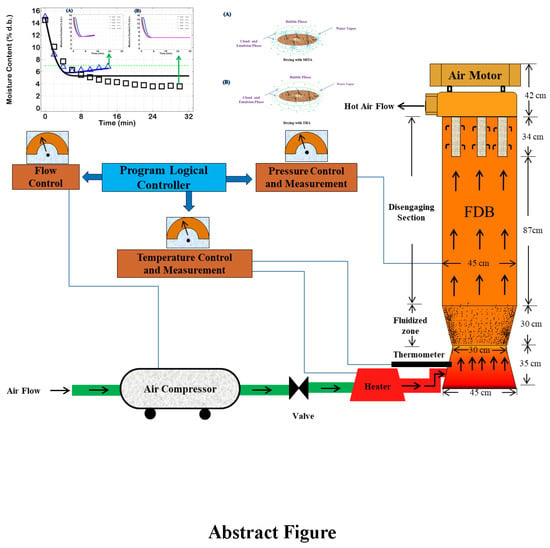Modelling Condensation and Simulation for Wheat Germ Drying in Fluidized Bed Dryer
Abstract
:1. Introduction
2. Materials and Methods
2.1. Materials
2.2. Fluidized Bed Dryer
2.3. Drying Experiment
2.4. Analytical Methods
3. Mathematical Modelling
3.1. Governing Equations and Assumptions
- (1)
- All particles of WG are uniform in size and shape [33].
- (2)
- All particles of WG have the same MC.
- (3)
- (4)
- (5)
- Cloud phase and emulsion phase are within one region [20].
- (6)
- Plug flow model is applied for air and mixed flow model is applied for emulsion phase.
- (7)
- The emulsion phase stays at minimum fluidizing conditions [21].
- (8)
- The size of bubble phase is uniform within the FBD [21].
- (9)
- The difference in temperature between emulsion phase and bubble phase is negligible.
- (10)
- Evaporation mechanism terminates during cooling.
3.1.1. Microscopic Energy Balance of Wheat Germ Particles
3.1.2. Microscopic Mass Balance of Wheat Germ Particles
3.1.3. Macroscopic Energy Balance of Emulsion Phase
3.1.4. Macroscopic Mass Balance of Emulsion Phase
3.1.5. Macroscopic Mass Balance of Bubble Phase
3.2. Material Properties of Wheat Germ
3.2.1. Density, Heat Capacity, and Thermal Conductivity Properties of Wheat Germ
3.2.2. Diffusivity of Moisture in Wheat Germ
3.3. Thermal Input for Drying Process
3.4. Numerical Step Function for Condensation
4. Results and Discussion
4.1. Physical Dimensions and Chemical Composition of Wheat Germ
4.2. Simulation of the Inlet Air Temperature of FBD
4.3. Macroscopic Behavior
4.3.1. Response of the Moisture Content of Wheat Germ
4.3.2. Responses of the Air Temperature in the FBD Chamber
4.3.3. Responses of the Simulated Thermal Input and the Absolute Humidity in the FBD Chamber
4.4. Microscopic Behavior
4.4.1. Responses of the Simulated Wheat Germ Temperature
4.4.2. Responses of the Simulated Moisture Distribution in Wheat Germ
5. Conclusions
Author Contributions
Funding
Conflicts of Interest
Nomenclature
| Symbol | Meaning (units) |
| surface area per unit volume of wheat germ (1/m) | |
| concentration of moisture in bubble phase (mol/m3) | |
| concentration of moisture in emulsion phase (mol/m3) | |
| concentration of moisture in wheat germ (mol/m3) | |
| saturation concentration (mol/m3) | |
| equilibrium moisture content (mol/m3) | |
| effective heat capacity (J/kg K) | |
| heat capacity of the jth compound (J/kg K) | |
| effective diffusivity of water in wheat germ (m2/s) | |
| equivalent diameter of wheat germ (m) | |
| pre-exponential factor (m2/s) | |
| activation energy of water diffusion (J/mol) | |
| step numerical parameter for condensation | |
| step numerical parameter for dehydration | |
| height of fluidization (m) | |
| convective heat transfer coefficient (W/(m K)) | |
| mass transfer coefficient between bubble and emulsion (1/s) | |
| mass transfer coefficient for condensation (m/s) | |
| mass transfer coefficient for dehydration (m/s) | |
| thermal conductivity of wheat germ (W/m K) | |
| molecular weight of water (kg/mol) | |
| radius of wheat germ (m) | |
| gas constant (J/mol K) | |
| relative humidity of air | |
| temperature (K, unless it is specified in °C) | |
| t | time (s) |
| r | r coordination (m) |
| x | x coordination (m) |
| WL | loading of wheat germ (kg) |
| initial moisture content of wheat germ (%, d.b.) | |
| Greek Symbols | |
| κ | thermal conductivity (W/m K) |
| porosity of bed | |
| ω | mass fraction |
| density (kg/m3) | |
| latent heat of vaporization (J/mol) | |
| Subscript | |
| ash | ash |
| b | bed |
| carb | carbohydrate |
| con | condensation |
| e | effective or emulsion |
| fat | fat |
| g | germ |
| h | heating |
| i | initial |
| in | inlet |
| j | jth compound |
| m | moisture |
| mb | moisture in bubble phase |
| me | moisture in emulsion phase |
| p | protein |
| sat | saturation |
| s | set |
| w | water |
References
- Mahmoud, A.A.; Mohdaly, A.A.A.; Elneairy, N.A.A. Wheat germ: An overview on nutritional value, antioxidant potential and antibacterial characteristics. Food Nutr. Sci. 2015, 6, 265–277. [Google Scholar] [CrossRef]
- Zhu, K.X.; Lian, C.X.; Guo, X.N.; Peng, W.; Zhou, H.M. Antioxidant activities and total phenolic content of various extracts from defatted wheat germ. Food Chem. 2011, 126, 1122–1126. [Google Scholar] [CrossRef]
- Li, B.; Zhao, L.; Chen, H.; Sun, D.; Deng, B.; Li, J.; Liu, Y.; Wang, F. Inactivation of lipase and lipoxygenase of wheat germ with temperature-controlled short wave infrared radiation and its effect on storage stability and quality of wheat germ oil. PLoS ONE 2016, 9, e0167330. [Google Scholar] [CrossRef]
- Jha, P.K.; Kudachikar, V.B.; Kumar, S. Lipase inactivation in wheat germ by gamma irradiation. Radiat. Phys. Chem. 2013, 86, 136–139. [Google Scholar] [CrossRef]
- Zou, Y.P.; Yang, M.; Zhang, G.; He, H.; Yang, T.K. Antioxidant activities and phenolic compositions of wheat germ as affected by the roasting process. J. Am. Oil Chem. Soc. 2015, 92, 1303–1312. [Google Scholar] [CrossRef]
- Murthy, K.V.; Ravi, R.; Bhat, K.K.; Raghavarao, K.S.M.S. Studies on roasting of wheat using fluidized bed roaster. J. Food Eng. 2008, 89, 336–342. [Google Scholar] [CrossRef]
- Jurkovic, N.; Colic, I. Effect of thermal processing on the nutritive value of wheat germ protein. Die Nahrung. 1993, 37, 538–543. [Google Scholar] [CrossRef] [PubMed]
- Ferrara, P.J.; Ridge, R.D.; Benson, J.T. Method of producing shelf stable wheat germ. US Patent 5063079, 5 November 1991. [Google Scholar]
- Srivastava, A.K.; Sudha, M.L.; Baskaran, V.; Leelavathi, K. Studies on heat stabilized wheat germ and its influence on rheological characteristics of dough. Eur. Food Res. Technol. 2007, 224, 365–372. [Google Scholar] [CrossRef]
- Xu, B.; Zhou, S.L.; Miao, W.J.; Gao, C.; Cai, M.J.; Dong, Y. Study on the stabilization effect of continuous microwave on wheat germ. J. Food Eng. 2013, 117, 1–7. [Google Scholar] [CrossRef]
- Xu, B.; Wang, L.K.; Miao, W.J.; Wu, Q.F.; Liu, Y.X.; Sun, Y.L.; Gao, C. Thermal versus microwave inactivation kinetics of lipase and lipoxygenase from wheat germ. J. Food Process Eng. 2015, 39, 247–255. [Google Scholar] [CrossRef]
- Kermasha, S.; Bisakowski, B.; Ramaswamy, H.; Van De Voort, B. Comparison of microwave, conventional and combination heat treatments on wheat germ lipase activity. Int. J. Food Sci. Technol. 1993, 28, 617–623. [Google Scholar] [CrossRef]
- Ali, S.; Usman, S.; Nasreen, Z.; Zahra, N.; Nazir, S.; Yasmeen, A.; Yaseen, T. Nutritional evaluation and stabilization studies of wheat germ. Pak. J. Food Sci. 2013, 23, 148–152. [Google Scholar]
- Marti, A.; Torri, L.; Casiraghi, M.C.; Franzetti, L.; Limbo, S.; Morandin, F.; Quaglia, L.; Pagani, M.A. Wheat germ stabilization by heat-treatment or sourdough fermentation: Effects on dough rheology and bread properties. LWT-Food Sci. Technol. 2014, 59, 1100–1106. [Google Scholar] [CrossRef]
- Fernando, W.J.N.; Hewavitharana, L.G. Effect of fluidized bed drying on stabilization of rice bran. Drying Technol. 1993, 11, 1115–1125. [Google Scholar] [CrossRef]
- Shingare, S.P.; Thorat, B.N. Fluidized bed drying of sprouted wheat (Triticum aestivum). Int. J. Food Eng. 2014, 10, 29–37. [Google Scholar] [CrossRef]
- Martinez, M.L.; Marin, M.A. Optimization of soybean heat-treating using a fluidized bed dryer. J. Food Sci. Technol. 2013, 50, 1144–1150. [Google Scholar] [CrossRef] [PubMed]
- Yondem-Makascıoglu, F.; Gurun, B.; Dik, T.; Kıncal, N.S. Use of a spouted bed to improve the storage stability of wheat germ followed in paper and polyethylene packages. J. Sci. Food Agric. 2005, 85, 1329–1336. [Google Scholar] [CrossRef]
- Hung, J.M. Investigation on the Effect of Fluidized-Bed Drying Processing on the Storage Stability of Wheat Germ. Master’s Thesis, Fu-Jen Catholic University, Taiwan, 2017. [Google Scholar]
- Yang, W.C. Handbook of Fluidization and Fluid–Particle System; Marcel Dekker: New York, NY, USA, 2003. [Google Scholar]
- Levenspiel, O. Chemical Reaction Engineering, 3rd ed.; John Wiley & Sons, Inc.: New York, NY, USA, 1999. [Google Scholar]
- Hemis, M.; Singh, C.B.; Jaya, D.S.; Bettahar, A. Simulation of coupled heat and mass transfer in granular porous media: Application to the drying of wheat. Dry Technol. 2011, 29, 1267–1272. [Google Scholar] [CrossRef]
- Srivastava, V.K.; John, J. Deep bed grain drying model. Energy Convers. Manag. 2002, 43, 1689–1708. [Google Scholar] [CrossRef]
- Giner, S.A.; De Michelis, A. Evaluation of the thermal efficiency of wheat drying in fluidized beds: Influence of air temperature and heat recovery. J. Agric. Eng. Res. 1988, 41, 11–23. [Google Scholar] [CrossRef]
- Naghavi, Z.; Moheb, A.; Ziaei-Rad, S. Numerical simulation of rough rice drying in a deep-bed dryer using non-equilibrium model. Energy Convers. Manag. 2010, 51, 258–264. [Google Scholar] [CrossRef]
- Vijayaraj, B.; Saravanan, R.; Renganarayanan, S. Studies on thin layer drying of bagasse. Int. J. Energy Res. 2007, 31, 422–437. [Google Scholar] [CrossRef]
- Zare, D.; Minaei, S.; Mohamad Zadeh, M.; Khoshtaghaza, M.H. Computer simulation of rough rice drying in a batch dryer. Energy Convers. Manag. 2006, 47, 3241–3254. [Google Scholar] [CrossRef]
- Proietti, N.; Adiletta, G.; Russo, P.; Buonocore, R.; Mannina, L.; Crescitelli, A.; Capitani, D. Evolution of physicochemical properties of pear during drying by conventional techniques, portable-NMR, and modeling. J. Food Eng. 2018, 230, 82–98. [Google Scholar] [CrossRef]
- Mohapatra, D.; Rao, P.S. A thin layer drying model of parboiled wheat. J. Food Eng. 2005, 66, 513–518. [Google Scholar] [CrossRef]
- Gili, R.D.; Martín Torrez Irigoyen, R.; Cecilia Penci, M.; Giner, S.A.; Ribotta, P.D. Physical characterization and fluidization design parameters of wheat Germ. J. Food Eng. 2017, 212, 29–37. [Google Scholar] [CrossRef]
- Gili, R.D.; Martín Torrez Irigoyen, R.; Cecilia Penci, M.; Giner, S.A.; Ribotta, P.D. Wheat germ thermal treatment in fluidised bed. Experimental study and mathematical modelling of the heat and mass transfer. J. Food Eng. 2018, 221, 11–19. [Google Scholar] [CrossRef]
- American Association of Cereal Chemists. Approved Methods of Analysis, 10th ed.; AACC International PRESS: St. Paul, MN, USA, 2000. [Google Scholar]
- Srinivasakannan, C.; Balasubramanian, N. An Analysis on Modeling of Fluidized Bed Drying of Granular Material. Adv. Power Technol. 2008, 19, 73–82. [Google Scholar] [CrossRef]
- Giner, S.A.; Calvelo, A. Modeling of wheat drying in fluidized bed. J. Food Sci. 1987, 52, 1358–1363. [Google Scholar] [CrossRef]
- Romeo, T.T. Fundamentals of Food Process Engineering, 3rd ed.; Springer Asia Limited: Hong Kong, China, 2007. [Google Scholar]
- Purlis, E. Baking process design based on modelling and simulation: Towards optimization of bread baking. Food Control. 2012, 27, 45–52. [Google Scholar] [CrossRef]
- Christie, J.G. Transport Processes and Separation Process Principles (Includes Unit Operations), 4th ed.; Goodwin, B., Ed.; Prentice Hall: Upper Saddle River, NJ, USA, 2003. [Google Scholar]
- Brandolini, A.; Hidalgo, A. Wheat germ: Not only a by-product. Int. J. Food Sci. Nutr. 2012, 63, 71–74. [Google Scholar] [CrossRef] [PubMed]
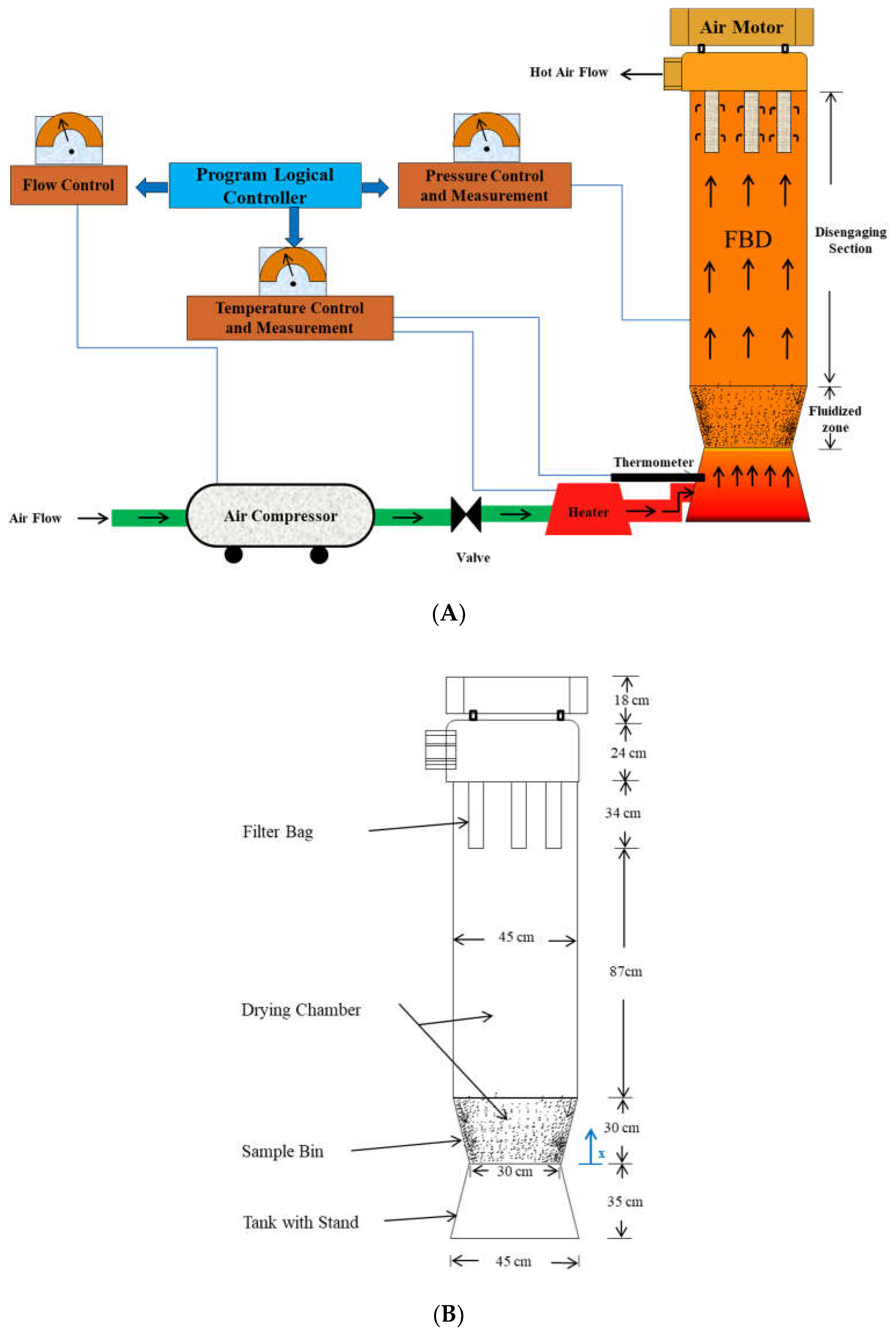
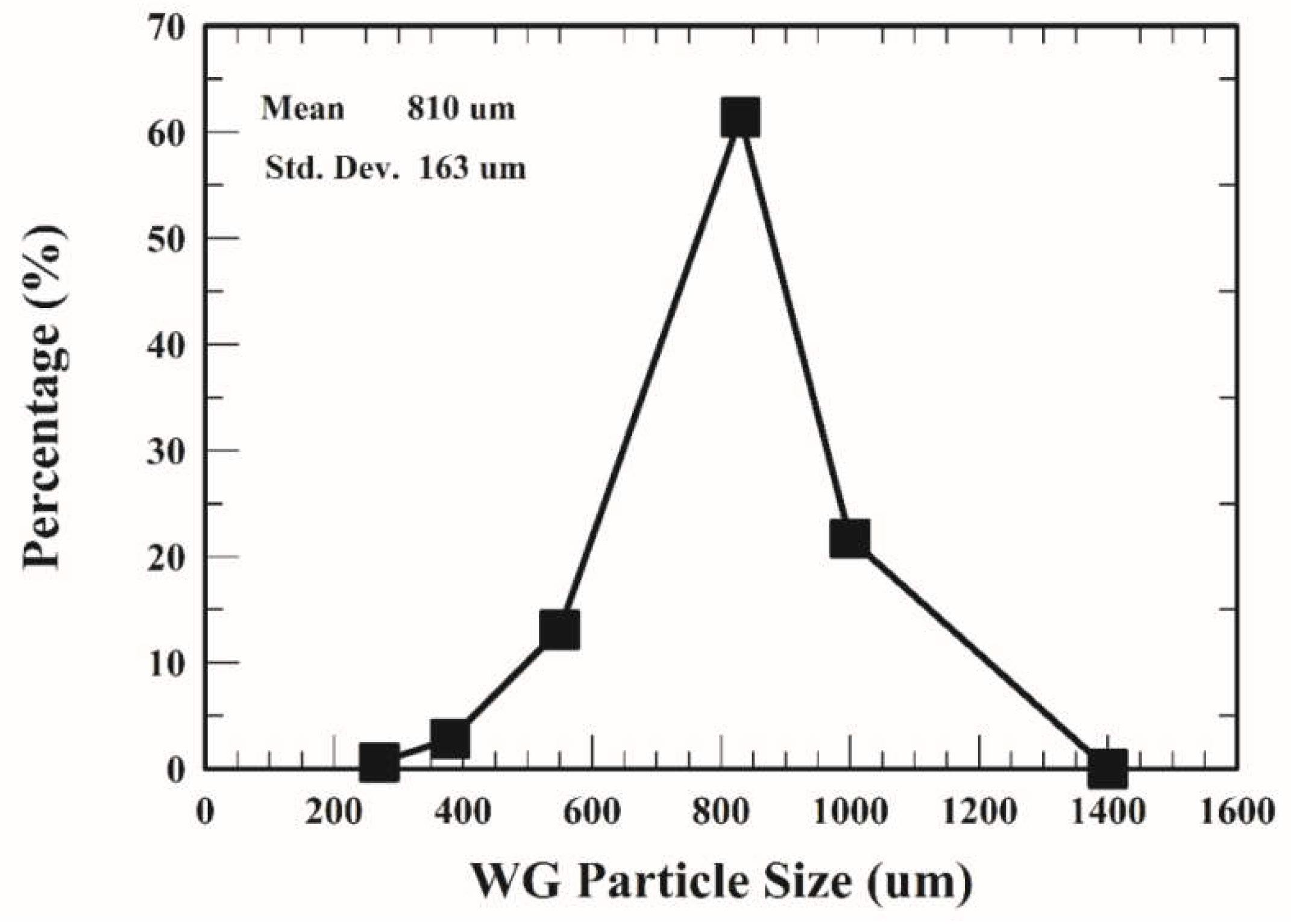
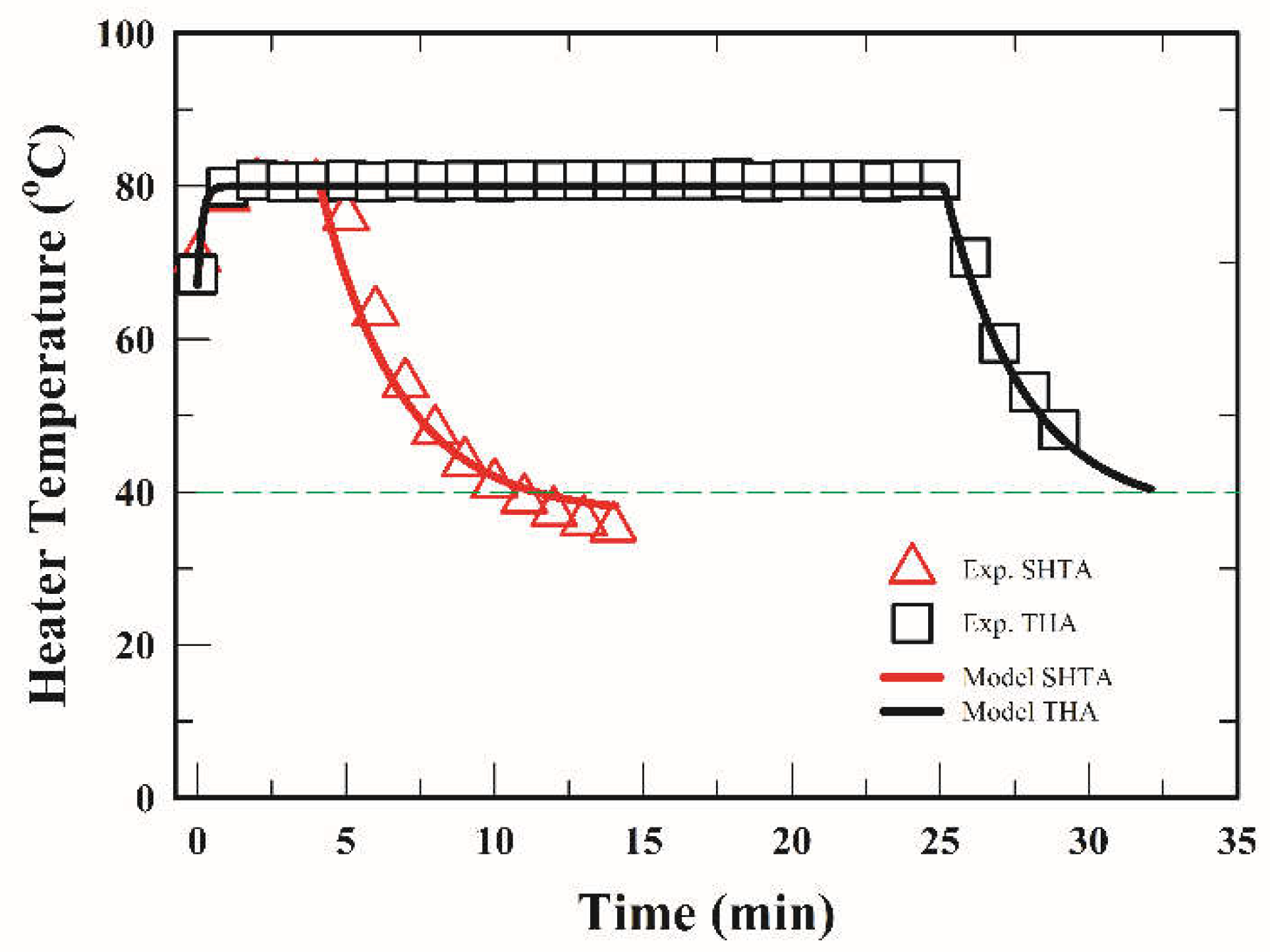

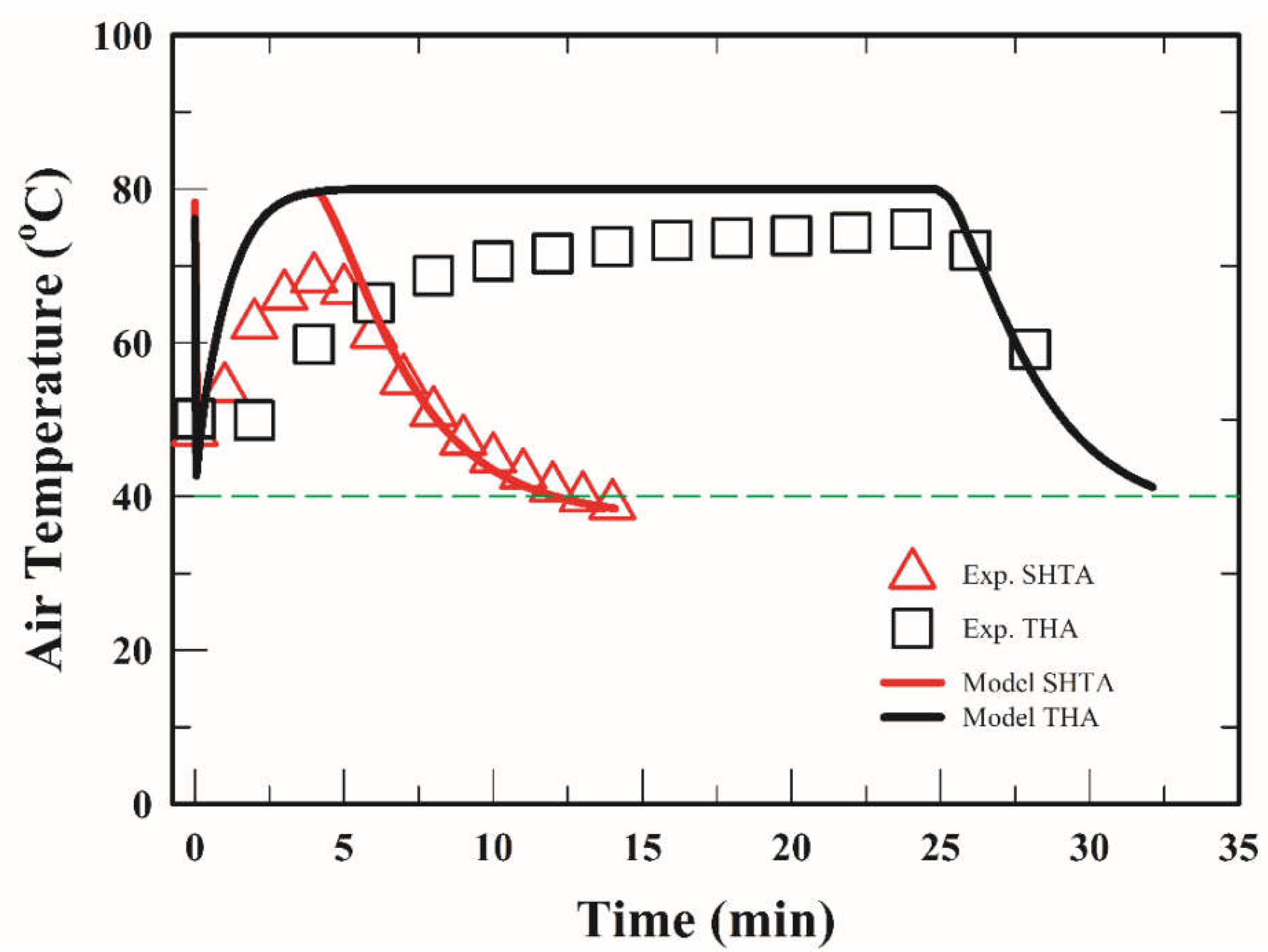
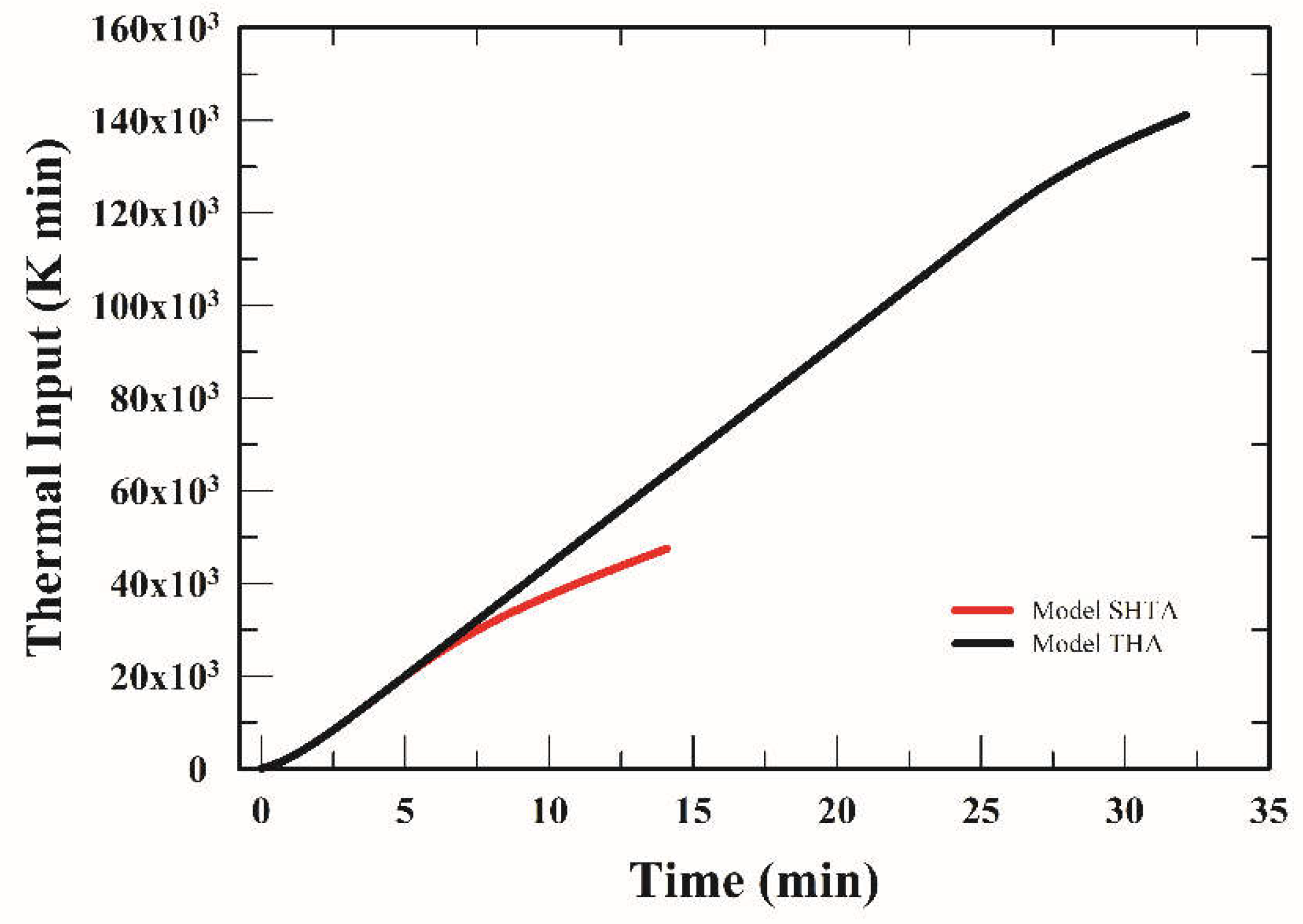
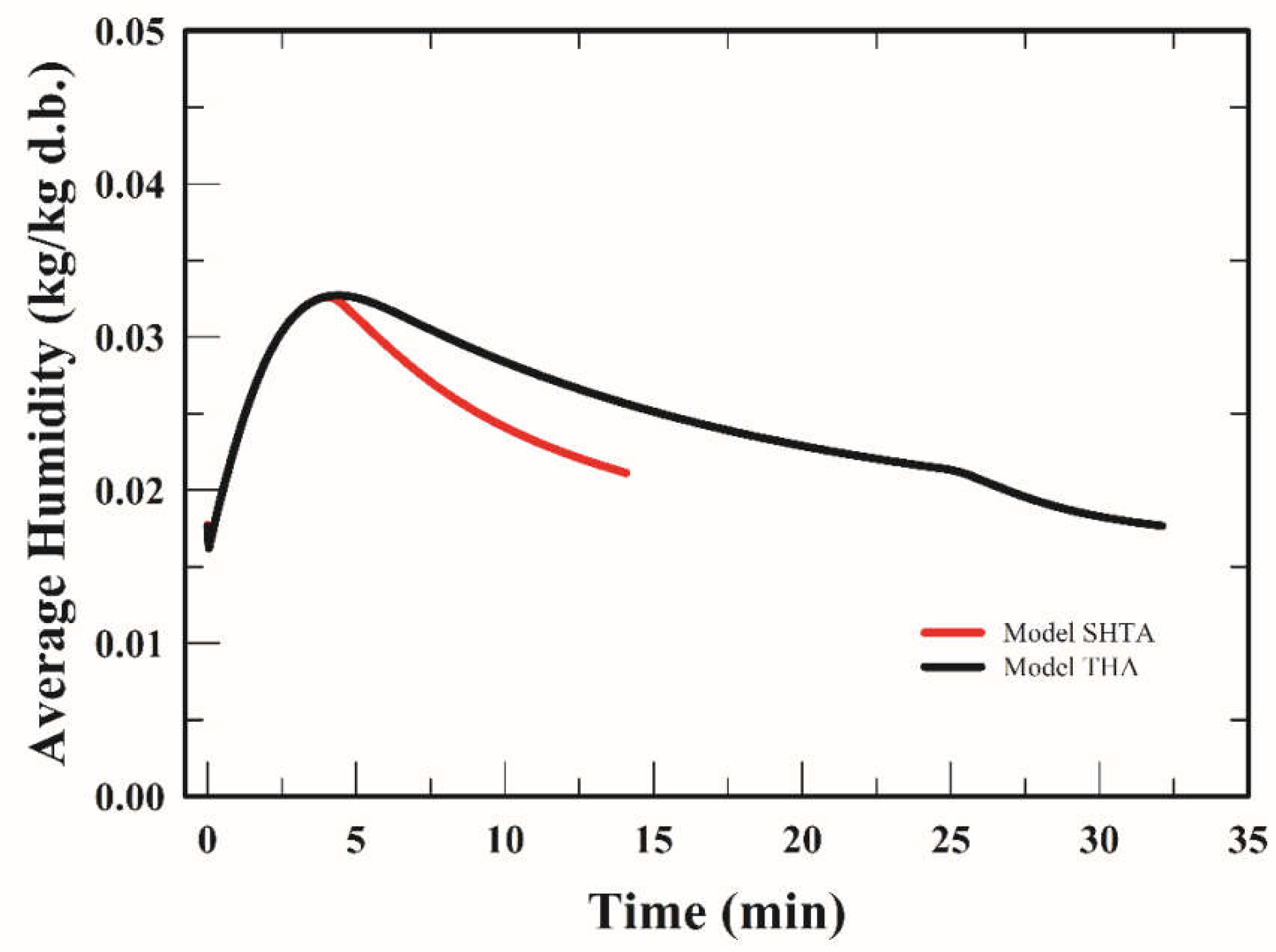
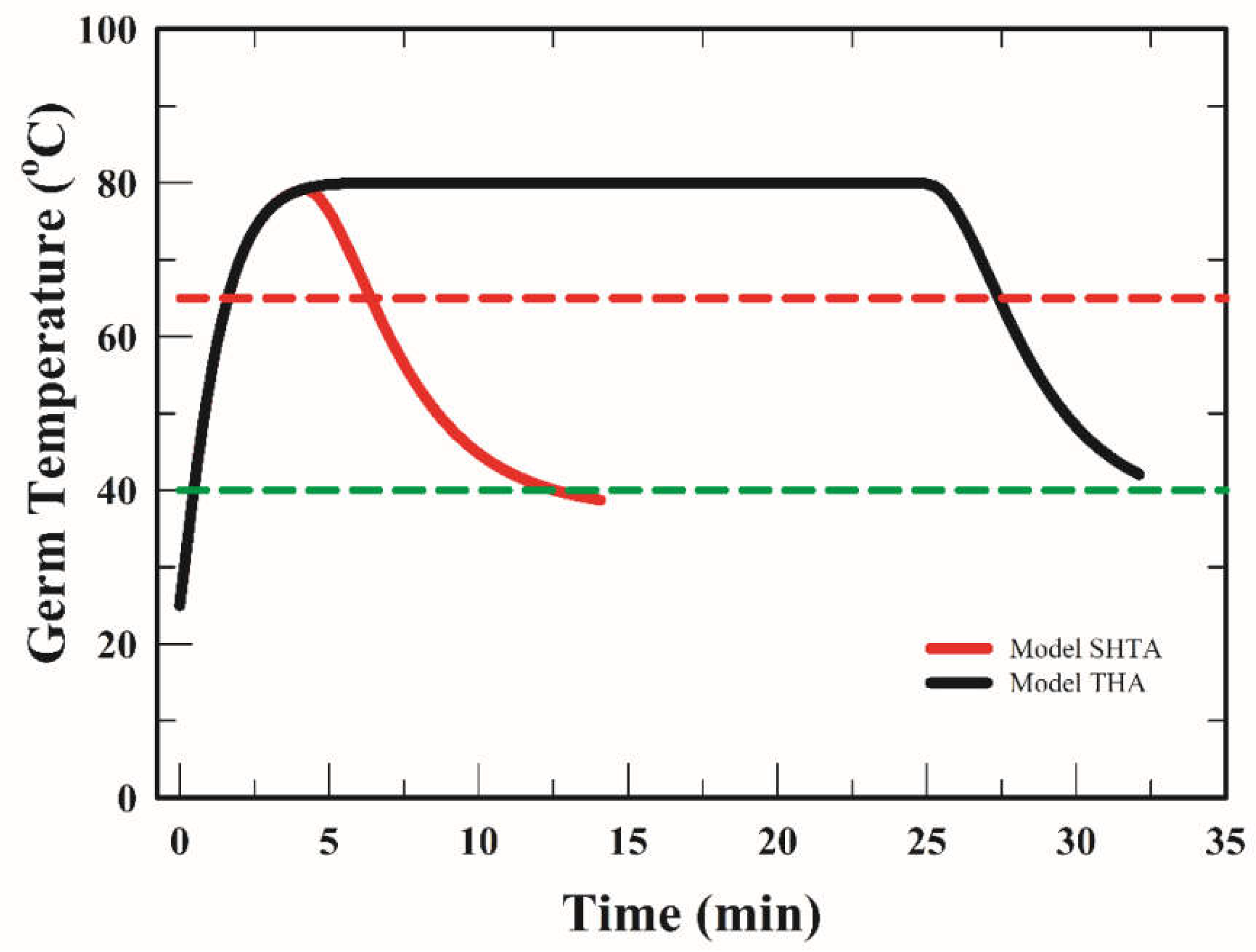

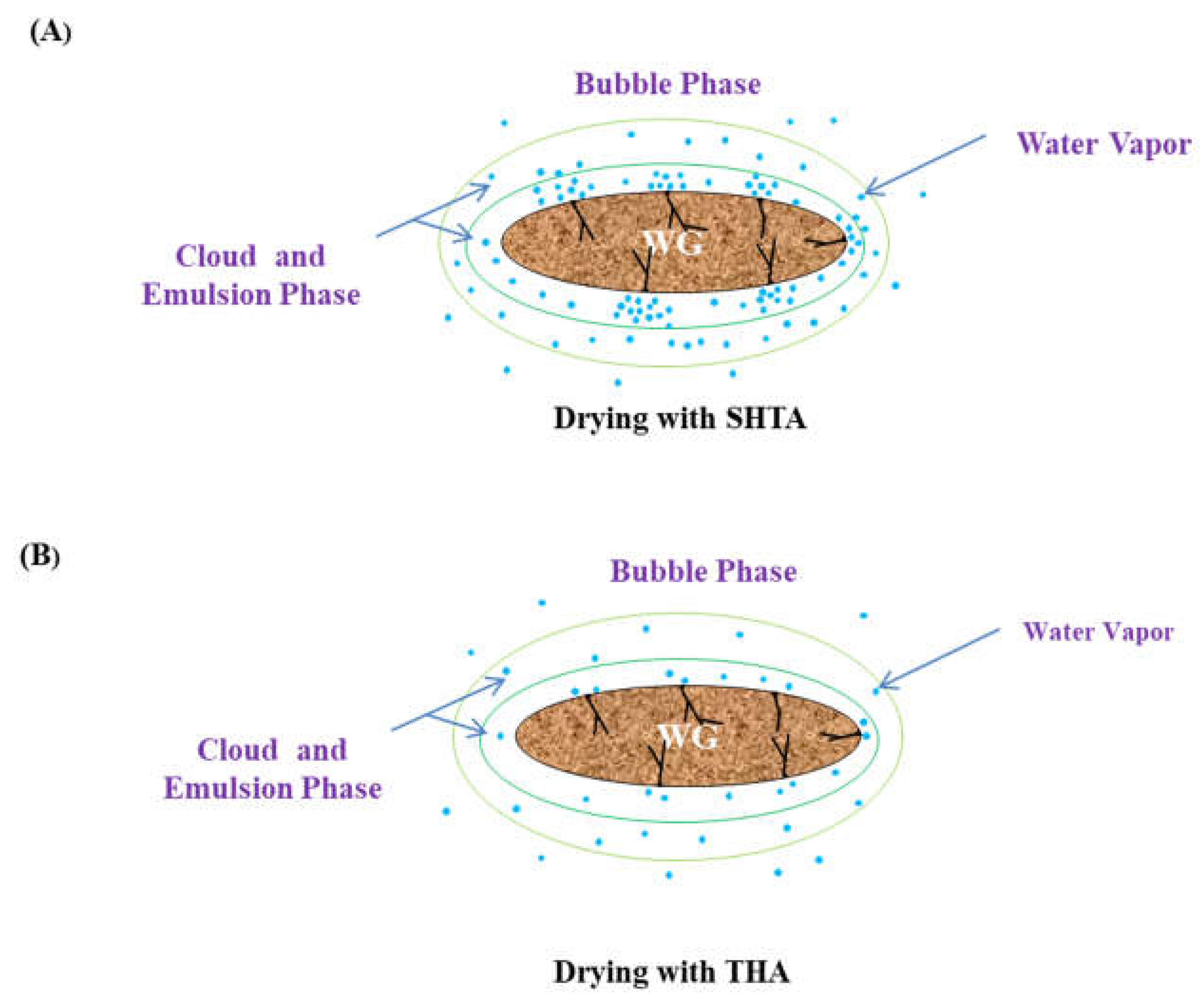
| Stages | Short Heating Time Approach (SHTA) | Traditional Heating Approach (THA) |
|---|---|---|
| Preheating | 10 | 10 |
| Sample Loading | 1 | 1 |
| Heating | 4 | 25 |
| Cooling | 10 | 4 |
| Description | Equation |
|---|---|
| Densityρg = Σρj ωj | ρw = 9.9718 × 102 + 3.1439 × 10−3 T − 3.7574 × 10−3 T2 |
| ρp = 1.3299 × 103 − 0.51814 T | |
| ρfat = 9.2559 × 102 − 0.41757 T | |
| ρcorb = 1.5991 × 103 − 0.31046 T | |
| ρash = 2.4238 × 103 − 0.28063 T | |
| Heat CapacityCP,g = ΣCP,j ωj | CP,w = 4.1762 + 9.0862 × 10−3 T − 5.4731 × 10−6 T2 |
| CP,p = 2.0082 + 1.2089 × 10−3 T − 1.3129 × 10−6 T2 | |
| CP,fat = 1.9842 + 1.4733 × 10−3 T − 4.8008 × 10−6 T2 | |
| CP,carb = 1.5488 + 1.9625 × 10−3 T − 5.9399 × 10−6 T2 | |
| CP,ash = 1.0926 + 1.8896 × 10−3 T − 3.6817 × 10−6 T2 | |
| Thermal conductivitykg = Σkj ωj | kw = 5.7109 × 10−1 + 1.7625 × 10−3 T − 6.7036 × 10−6 T2 |
| kp = 1.788 × 10−1 + 1.1958 × 10−3 T − 6.7036 × 10−6 T2 | |
| kfat = 1.8071 × 10−1 − 2.7604 × 10−3 T − 1.7749 × 10−7 T2 | |
| kcarb = 2.014 10−1 + 1.3874 × 10−3 T − 4.3312 × 10−6 T2 | |
| kash = 3.296 × 10−1 − 1.401 × 10−3 T − 2.9069 × 10−6 T2 |
| Moisture | Protein | Fat | Carbohydrate * | Ash |
|---|---|---|---|---|
| 13.15 ± 0.28 | 24.11 ± 0.23 | 9.02 ± 0.13 | 48.2 | 5.91 ± 0.34 |
| Measured | Estimated | Set | Theoretical | ||||
|---|---|---|---|---|---|---|---|
| Parameter | Value | Parameter | Value | Parameter | Value | Parameter | Value |
| Hf | 0.30 m | Ag | 7407 1/m | Do | 2.3 × 10−4 m2/s | Mw | 0.018 kg/mol |
| RHi | 0.15 (-) | rg | 4.05 × 10−3 m | Dv | 1.0 × 10−5 m2/s | RT | 0.08205 atm/mol·K |
| RHin | 0.75 (-) | n | 0.36 | Ea | 29.4 × 103 J/mol | Rg | 8.314 J/mol·K |
| Tgi | 298.15 K | h | 32.5 W/m2 K | λ | 41.4 kJ/mol | ||
| Tstart | 340.15 K | Kcon | 4.5 × 10−3 m/s | ||||
| WL | 2.0 kg | Kde | 1.2 × 10−2 m/s | ||||
| u | 1.2 m/s | Kbe | 1.2 × 10−3 m/s | ||||
| VT | 0.214 m3 | ||||||
| Xwi | 15% d.b. | ||||||
| 0.92 (-) | |||||||
| Kcon (m/s) | ||||||
| 0 | 1.0 × 10−3 | 4.5 × 10−3 | 9.0 × 10−3 | 1.8 × 10−2 | ||
| Time (min) | Experimental MC | Predicted MC | ||||
| 0 | 15 | 15 | 15 | 15 | 15 | 15 |
| 2 | 8.84 | 9.56 | 9.56 | 9.56 | 9.56 | 9.56 |
| 4 | 6.81 | 6.43 | 6.43 | 6.43 | 6.43 | 6.43 |
| 6 | 6.15 | 5.89 | 5.90 | 5.9 | 5.91 | 5.93 |
| 8 | 6.29 | 5.89 | 5.94 | 6.08 | 6.25 | 6.53 |
| 10 | 6.31 | 5.89 | 6.01 | 6.4 | 6.82 | 7.46 |
| 12 | 6.61 | 5.89 | 6.09 | 6.71 | 7.32 | 8.14 |
| 14 | 6.85 | 5.89 | 6.17 | 6.96 | 7.68 | 8.53 |
| AAD | 0.48 | 0.40 | 0.23 | 0.43 | 0.74 | |
© 2018 by the authors. Licensee MDPI, Basel, Switzerland. This article is an open access article distributed under the terms and conditions of the Creative Commons Attribution (CC BY) license (http://creativecommons.org/licenses/by/4.0/).
Share and Cite
Chan, D.-S.; Chan, J.-S.; Kuo, M.-I. Modelling Condensation and Simulation for Wheat Germ Drying in Fluidized Bed Dryer. Processes 2018, 6, 71. https://doi.org/10.3390/pr6060071
Chan D-S, Chan J-S, Kuo M-I. Modelling Condensation and Simulation for Wheat Germ Drying in Fluidized Bed Dryer. Processes. 2018; 6(6):71. https://doi.org/10.3390/pr6060071
Chicago/Turabian StyleChan, Der-Sheng, Jun-Sheng Chan, and Meng-I Kuo. 2018. "Modelling Condensation and Simulation for Wheat Germ Drying in Fluidized Bed Dryer" Processes 6, no. 6: 71. https://doi.org/10.3390/pr6060071





